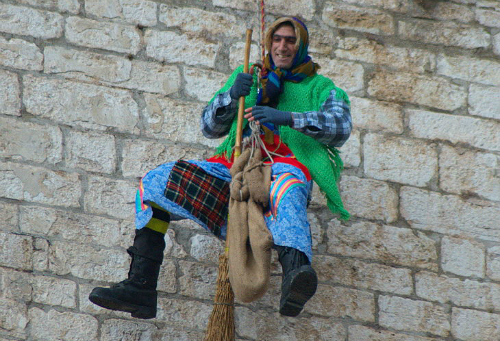The ads are appearing on TV, the decorations are going up and the shops are filling with frantic shoppers. Christmas is definitely coming.
Like a magical sleigh pulled by a troupe of gravity-defying reindeer, the Christmas season sweeps over the world, sprinkling seasonal joy and jarring advertising alike. That’s not to say that everyone celebrates the most wonderful time of the year in the same way.For us here in the Northern hemisphere we can look forward to a winter wonderland of rushing through the snow on our way to build snowmen and go ice skating on picturesque frozen ponds. Well, maybe not quite so snowy, but even down under, where summer heatwaves greet the holiday season, Christmas cards depict snowdrifts and wooly scarves.
This is even more bizarre when you consider that Aussies flock to the beach in their thousands on Christmas Day.
It seems every country has a different way of celebrating Christmas, some closely tied to religious tradition, some to ancient rituals and others to recent business strategies.
Whatever their tradition, we’ve brought you a run down of the most unusual Christmas traditions, so wherever you are in the world this yuletide, you’ll not be surprised by what’s going on.
Italy’s strong Catholic heritage means that they do things a little differently when it comes to Christmas. The holiday season continues through December and culminates in January with the Feast of Epiphany.
Whilst the feast celebrates the three kings’ visit to Jesus, Italian youngsters know it as the day when La Befana comes to visit. Befana is a kindly witch who, legend has it, helpfully gave directions to the kings as they journeyed to Bethlehem. Other interpretations suggest that the woman lost her infant son, and maddened with grief she visited the infant Jesus bringing presents. To cure her anguish Jesus made her honorary mother to all children in Italy, curing her of her madness.
Befana is a mish-mash of familiar legends. She flies on a broomstick and wears a pointy hat, but also climbs down chimneys to deliver sweets and presents to good children. Bad children are gifted a lump of coal, and anyone naughty enough to get of bed to sneak a look at the witch gets a thump with her broomstick.
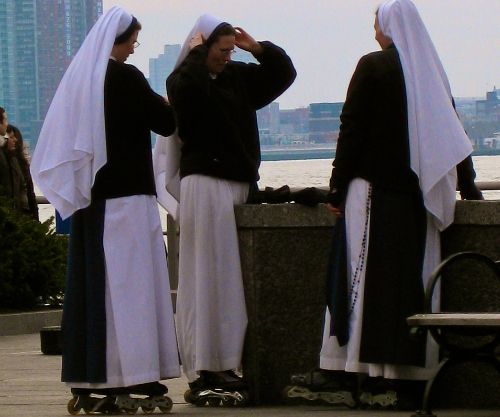
© aprilzosia
Another proudly Catholic country, Venezuela celebrates Christmas with a series of Mass ceremonies throughout the advent period. Devout worshippers stay up for midnight services or rise early for early morning mass.
Whilst the centuries-old tradition of Mass is common across the Catholic world, it’s a relatively new aspect to the service that Venezuelans have made as key feature of their festive fun. They roller skate to church.
It’s not clear exactly when the devout started skating to the sacrament, but it is so well established that the streets of Caracas are closed to traffic during the mornings in December so that wheeled worshippers can skate safely to church.
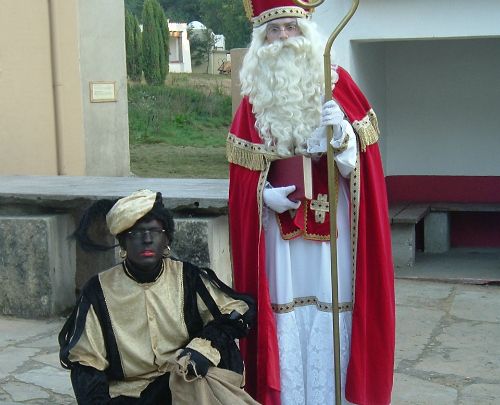
© Looi
Pietr is one of Europe’s oldest Christmas characters, and one of the most controversial. In medieval artworks St Nicholas is often seen taming a chained demon, often depicted as black in colour.
Later interpretations transformed a grumpy and severe St Nicholas into a kindly and generous old man, Sinterklaas. With this makeover Sinterklaas gained a servant, a black man who captures naughty children in a burlap sack and carries them off to Spain. Pietr appeared in various books and prints in African dress but also inspired fancy dress at festivities.
Christmas parades and parties have featured blacked-up performers as Pietr alongside the more familiar bearded Sinterklass. He’s not always been welcome, with discussions on his relevance taking place since the mid-20th century. Dutch comedians who appear as the character have called for his retirement, as has Russell Brand and even the Dutch version of Sesame Street discussed how offensive he could be.
That’s not to say that Pietr doesn’t have his fans; in 2014 supporters clashed with protestors, resulting in 90 arrests. We wonder if these naughty boys and girls got visited by Pietr himself.
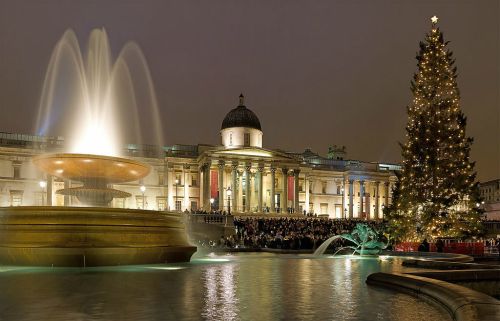
© David Iliff
What would Christmas be without a Christmas tree? Decorating the home with a green fir might be a German tradition, but it has spread and evolved around the world, with revellers in India sprinkling tinsel on banana trees.
Of course it isn’t just homes that see trees potted and draped in twinkling lights. City residents often gather around a communal tree for concerts and celebrations. New Yorkers gather under the Rockefeller Centre tree and Lisbon boasts the world‘s tallest, but London’s tree has a tale to tell.
The tree is a gift from the Norwegian government, shipped over each year to commemorate the help British forces gave to Nazi-occupied Norway during World War II.
Gifted annually since 1947, the 50-year-old spruce is usually over 20 metres tall and, decorated in traditional Norwegian style, boasts 500 lights.
Events held around the tree raise money for charities and voluntary groups.
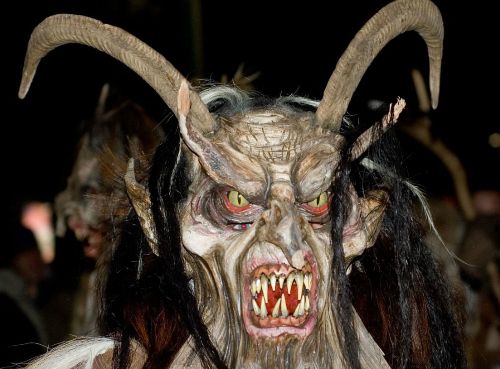
© Anita Martinz
Much like Zwarte Pietr, Krampus is St. Nicholas’ sidekick, doling out punishment to naughty Austrian children. But where Pietr stirs controversy, Krampus inspires utter terror.
Sporting giant horns and gnashing teeth, Krampus is a demon-like character with cloven hooves and a lolling tongue. Whipping chains around, he carries children off to be drowned or eaten.
Krampus enjoys his own night of festivities, Krampusnacht, where men dress up at the terrifying character and visit homes and businesses. It’s tradition to offer the visiting demon a swig of schnapps to avoid his displeasure.
Austrians began sending alternative Christmas cards in the 1800s, featuring the beast kidnapping squealing brats or getting up to no good with buxom alpine ladies of loose morals.
Unlike Zwarte Pitr, Krampus’ popularity is growing by the year, with costumes getting creepier every Christmas.
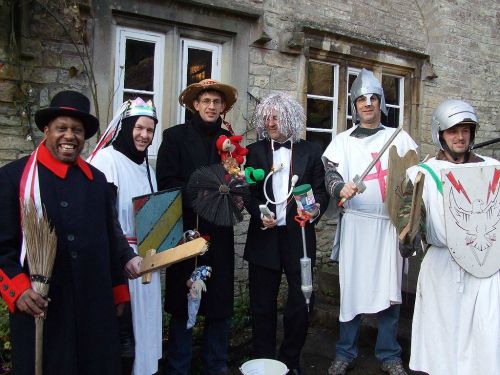
© Rodw
Originally from Britain, the practice of staging ‘Mummers Plays’ spread across the empire and now continues in isolated pockets around the world.
Records show that 13th century performers put on these ad-libbed performances for the amusement of the royal court but, also toured the country performing at pubs and meeting houses in return for donations.
Like an early improv-comedy troupe, the performers respond to heckling from the audience. A precursor to modern pantomimes, the plays usually featured men in drag, performers playing animals, and musical numbers.
Similar folk plays were popular worldwide, getting mentions in Tolstoy’s War and Peace, but the practice began to die out after World War I.
Today, troupes of Mummers can be found in Newfoundland and Philadelphia but are rarely found elsewhere in the world.

© Canada Forces
There’s nothing Christmassy about nuclear weapons, but a US Air force officer accidentally instituted one of the newest festive traditions whilst commanding North America’s atomic arsenal.
In 1955 the Sears department store catalogue ran an ad, inviting children to call a telephone number and talk directly to Santa. With astronomical odds, the ad was misprinted, instead featuring the number for NORAD, the super-secret nuclear nerve centre.
Phones began ringing off the hook in the control room, not with orders to begin nuclear Armageddon, but with America’s youngsters asking to speak to jolly old Santa.
Colonel Harry Shoup, the officer in charge on Christmas Eve ordered his staff of highly trained troops to update the youngsters on Santa’s progress on his international present delivery mission.
Now a team of military and civilian volunteers handle thousands of calls and emails throughout the night. The military have even teamed up with Google and Bing in previous years to make their tracking data available to the public.
There’s nothing quite like a nuclear superpower celebrating the season of peace and goodwill.

© Catherine
Christmas dinner is a staple part of celebrations worldwide. Whatever its ingredients, festive families gather around the table and tuck into homemade hearty fare.
Not in Japan though. Revellers there enjoy a Kentucky Fried Christmas thanks to an advertising campaign from the 1970s. The country doesn’t officially mark Christmas, but families have founded a tradition of hitting the fast food chain to celebrate regardless.
A group of foreigners in the country discovered that turkey is difficult to acquire in Japan, so KFC launched a ‘Christmas Chicken’ campaign. The seasonal menu is still popular, with families booking months in advance for fried chicken, wine, cake and champagne for US $40.
The fast food chain is so entwined with Japanese Christmas traditions that youngsters don’t distinguish between Santa Claus and brand mascot Colonel Sanders when it comes to jolly bearded chaps.
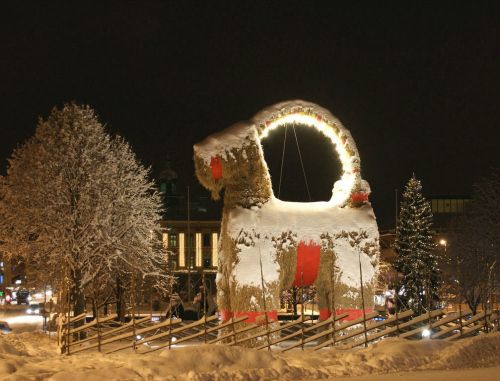
© Seppo Laine
Santa may be famous through much of the world for ripping through the sky on his Norwegian reindeer, but in Scandinavia he’s known for riding a humble goat. ‘Julebocken’, or ‘Yule Goat’ is a popular Christmas image across the frozen north, but one Swedish town has had some trouble with this hapless animal.
Gävle decided in 1966 to kick off festivities with a giant sculpture of the Julebocken made of straw. Sadly the three-tonne animal was barbecued when the straw caught fire, sparking an unusual tradition.
Each year the town celebrates with the gargantuan goat, only to see it reduced to ashes or otherwise defiled. The poor creature has been kicked to pieces, destroyed in a bizarre car crash and been used as a love nest for scandalous Swedes .
An on-going battle has been fought between generations of vandals and city officials; the city has tried erecting fences, employing security guards and even fireproofing the beast, all to no avail.
The unlucky goat has been destroyed in so many ways that in 1988 English bookmakers allowed gamblers to place bets on the fate of the sculpture. Some have even come to regard the goat’s annual demise as a part of the tradition.
In 2001 an American visitor to the city spent 18 days in jail for setting the animal ablaze.
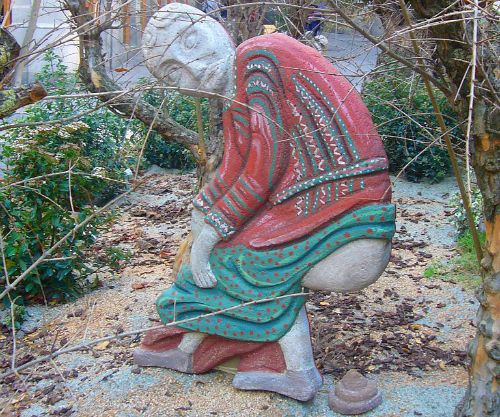
© Jordiferrer
Nativity scenes are popular Christmas traditions around the world, but in the Catalan region they are a big part of the season’s celebrations. Often dominating a town square, these miniatures don’t just show the stable with adoring visitors crowding around the manger.
These mega-models depict the entire town of Bethelehem in stunning detail. Entire family dramas will play out among the tiny buildings, women will be seen spinning wool into cloth, soldiers will patrol the streets and one cheeky chappy will bare his behind.
Amidst this depiction of the holiest moment in the Christian faith is a man with his trousers down relieving himself. It seems odd that a pooping porcelain man should appear in the scene, but ‘El Caganer’ is an integral part of the Catalan Christmas.
There are various arguments about why he’s there. Some say he is fertilizing the land and is a good luck charm to guarantee a good harvest next year. El Caganer often depicts local authority figures, so some argue that he’s a way for locals to vent their feelings at unlikable authority figures.
Whatever the reason, El Caganer is here to stay. Attempts to remove his from the nativity scene have caused outrage in recent years. In 2005 Barcelona outlawed public defecation, and in turn El Caganer was wiped clean off the model. Angry letters flooded the local papers: if the Caganer is now an outlaw, they said, he should be left in the scene but joined by an angry policeman writing him out a fine.
El Caganer has the bare-faced cheek to defile Christmas celebrations, but adults love his historical significance and kids love to look out for him hiding in the miniature city streets.
What are your favourite Christmas traditions? What surprised you about your first Christmas as an expat? Let us know in the comments!
Article by Andy Scofield

